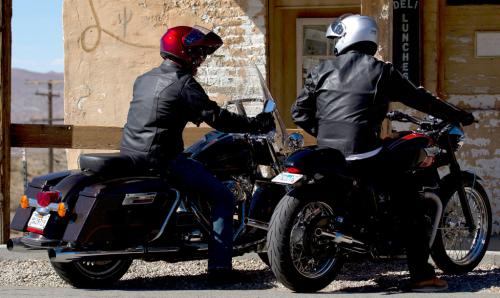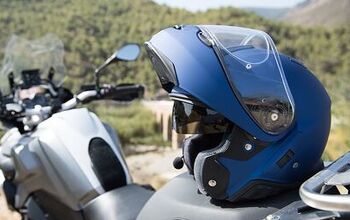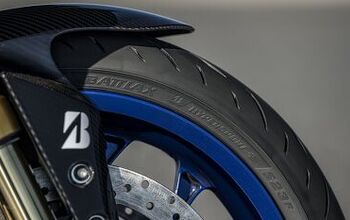Shoei Neotec Helmet Review
In the motorcycle world, compromise is an ever-present issue. Want a nimble sportbike with the comfort of a Gold Wing? Sorry, that’s impossible. How about a modular-style flip-front helmet that can deliver the freedom of an open-face lid but with the comfort and safety of a full-face helmet?
Well, that’s getting closer to reality, as our experience with Shoei’s new Neotec helmet proved.
I’ve sampled a few modular helmets previously, based on the allure of open-face-style eating, drinking and talking, plus the adaptability of full-coverage protection when required. Cheaper modular lids are noisy and feel only modestly protective while lacking the comfort of premium helmets. Costlier modulars, like the Schuberth C3, enjoy much better build quality, but they have an interior shape that doesn’t fit long-oval heads well.
Enter Shoei’s new Neotec, the best modular helmet we’ve yet sampled. Shoei’s first modular, the Multitec, was introduced in 2007 and still remains in the lineup. The Neotec uses lessons learned from the Multitec to deliver a completely new modular. Updates include a reduction of wind noise, a wider and taller field of vision, a fully removable, washable and replaceable liner system, plus an internal sun visor, Shoei’s first.
Shoei describes the Neotec as “The next level of modular helmet design for today’s hybrid motorcyclists.”
The Neotec makes a great first impression, as its finish quality is definitely at the high end. The Anthracite Metallic color of our sample looks smooth and deep, and the gently curving surfaces give it a classy appearance. The shell combines five plies of fiberglass with organic fibers.
Slipping on the Neotec is especially easy when the chin bar is in its raised position, just like a traditional three-quarter helmet. Once inside, it has an enviable yet difficult to achieve combination of feelings: comfort and protection. The interior feels plush and luxurious, snugly forming around my cranium in an enveloping hug. Ear pockets can easily swallow speakers for a communications system.
Shoei has designed three shell sizes for the Neotec to accommodate various noggins, and cheek pads are available in different thicknesses for $46.80. Shoei tells us customers can exchange the cheek pads free of charge as long as they are unused, and some larger dealerships carry a variety of sizes that can be swapped at the time of purchase.
Flipping down the chin bar for the first time reveals the careful engineering of the 360-degree Pivot Locking System, made of stainless steel components. It closes with a reassuringly secure thunk unlike the cheapie modulars I’d sampled – like a Mercedes door close compared to a Kia’s. The Neotec’s chin bar protrudes out further than the Multitec, allowing extra space for those large of chin.
Releasing the chin bar couldn’t be much easier, with a large lock-release button at the chin area simply triggering the internal mechanism, followed by merely lifting the chin piece to raise it smoothly upward. Notches in the mechanism keep the chin bar securely in its raised position until it’s needed.
The Neotec enjoys an airier cockpit than the Multitec thanks to its larger eyeport, both taller and wider with the CNS-1 faceshield that is scratch-resistant and comes equipped with the Pinlock Fog-Resistant System. Pinlock posts on the inside of the shield allows fitment of a thin plastic layer that resists fogging. The Neotec’s QR-N base-plate system makes for easy shield changes, and the shield’s “dual-ridge window bead” offers a secure gasket to seal out wind and rain. The Multitec has a single-ridge bead.
Also new is the inclusion of the retractable QSV-1 sun shield, operated by a slider on the left side of the Neotec. It’s claimed to block 99% of UV rays, as does the CNS-1 external shield, and can be a godsend when the sun is low on the horizon. The forehead area of the Neotec bulges outward (compared to the Multitec) to accommodate the QSV-1, and the extra components makes the Neotec slightly heavier than its predecessor.
Shoei uses wind-tunnel testing to optimize aerodynamics, and the Neotec’s shape is designed to minimize wind noise. Most notable are the outward-flaring “Vortex Generator” lips at the chin bar’s trailing-edges which directs airflow away from the joint where it connects to the main shell – a typical source of noise on a modular helmet.
Fresh air is facilitated by three ports in the helmet. A vent in the chin area directs air up the inside of the faceshield when opened, providing a breath of fresh air at the expense of a tad more wind noise. In the forehead area is a three-position intake significantly larger than the Multitec’s, and it’s very effective in grabbing air and ramming it through channels built into the Neo’s dual-layer EPS liner. An extractor vent at the upper rear draws out stale air, a feature lacking on the Multitec. All controls are easy to operate while wearing gloves.
A spoiler integrated into the rear of the shell shape is said to reduce lift and drag, and the Neotec impresses for how smoothly it slips through highway-speed atmosphere without fuss or stability issues. Vent efficiency is top-notch, providing ample and noticeable cooling airflow over a rider’s head. And if that’s not enough of a breeze, riding with the faceshield open is another option, as the sun visor blocks most of the wind from hitting your eyes.
Interior sound levels are remarkably subdued for a modular helmet, quieter, in fact, than many full-face lids. I’m tempted to describe the Neotec as the quietest modular out there, but Schuberth’s C3 is simply outstanding in that respect. A close second, I’d say.
So, a lot of positive things to say about a well-designed helmet, but there are two potential caveats.
First, this is an expensive helmet. Neotecs start at a lofty $648.99 and go up to $662.99 for any color but black or white. And yet, as Shoei has consistently showed us over the years, you really do get what you pay for, and the Japanese company backs up the Neotec with an impressive 5-year warranty. Also, it’s worth noting that just about any helmet can be bought below MSRP if you shop around, so do your homework and save a few bucks.
The other factor that might play a role in your helmet selection is that the Neotec doesn’t receive Snell certification, only DOT-level approval like any modular helmet. Personally speaking, it’s not an issue at all for me, especially for a lid that’s designed to be worn solely on the street, not the racetrack.
Overall, I’m thrilled with my Neotec. I love it for its incredible versatility, plush coziness and its classy appearance. It’s pulled on my head more often than anything else currently in my collection, and that’s about the highest endorsement I can give.
SHOEI SAFETY HELMET CORP.
3002 Dow Ave., Suite 128
Tustin, CA 92780
Phone: 714-730-0941
Fax: 714-730-0942
[email protected]
Related Reading
2012 Shoei RF-1100 Helmet Review
2011 Shoei Qwest Helmet Review
2011 Arai Signet-Q Helmet Review
2010 Arai Corsair V Helmet Review
More by Kevin Duke

































Comments
Join the conversation